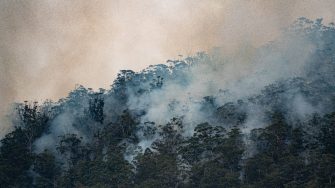
UPDATE - WITHDRAWN
Bushfires command a powerful presence in the Australian psyche as a threat to human life and property, as a core part of indigenous culture and as one of the primary drivers of ecosystem dynamics. Plants are adapted to the fire regime, and changes to any aspect of this regime, including frequency, season and severity, could mediate whether a species persists or becomes locally extinct. Indigenous people have carried out a range of different traditional burning practices to care for country across contrasting Australian landscapes for thousands of years. Today, hazard reduction burning is often seen as a panacea to mitigate threats that wildfires pose to life and property. Although fire is widely recognised as a key tool for land management, identifying fire regimes that meet the needs of biodiversity conservation, cultural wellbeing and human safety present a major challenge for fire researchers and managers.
Historical fire regimes that resulted from traditional indigenous management are poorly understood, especially in southern Australia, but are likely to have been compatible with conservation of native flora, which persisted through millennia of aboriginal occupation. In the absence of information on traditional fire regimes in southern Australia, it's sometimes assumed that conservation and cultural objectives can best be served by transposing contemporary traditional burning practices from tropical northern Australia into the south. Some commentators also suggest that contemporary hazard reduction practices could replicate traditional burning practices. These propositions can be tested by examining the sensitivity of plant life-history responses to fire frequency, severity and season to identify the fire regimes that could and could not have been implemented historically, given that extant plant species must have persisted through the historical aboriginal fire regimes.
The key challenge is to incorporate the substantial wealth of existing traditional knowledge with scientific data on species fire responses to identify the fire regimes that are consistent with cultural objectives as well as the conservation of threatened species.
The results will help indigenous communities by resolving some of the uncertainties about the nature of traditional indigenous fire management in southern Australia.
The project will be supported by the National Environmental Science Program (NESP) Threatened Species Recovery Hub based within the Centre for Ecosystem Science. The student will learn field- and lab-based skills such as plant population monitoring, on-ground vegetation surveys, assessment of fire severity and use of unmanned aerial vehicles (UAV) for post-fire monitoring. The student will also learn technical skills, including experimental design, statistical analyses of field data and processing of UAV imagery.
This project is aimed at individuals who identify as Aboriginal or Torres Strait Islander.
This project comes with $40,000 per year stipend and $10,000 of research funding per year for four years. It's open to both Australian and international applicants. Australian applicants can start early in 2017, the expected start date for international applicants is August 2017. Further information on the reintroduction project can be found on the NESP threatened species website.
For additional information, contact Professor David Keith on david.keith@unsw.edu.au. Deadline is November 11.
